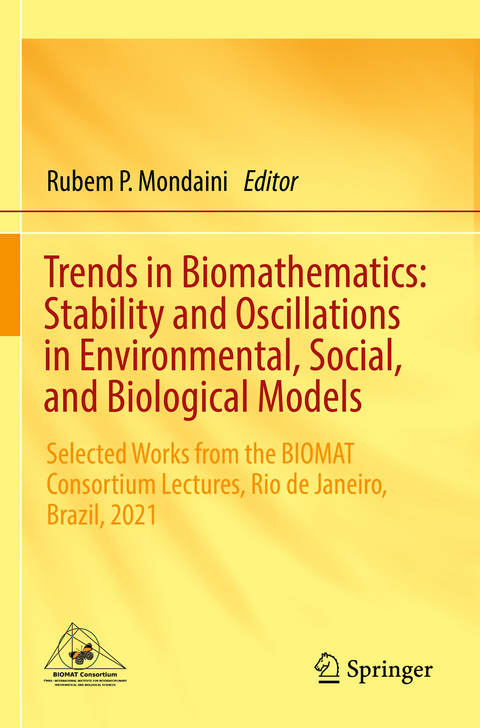
Trends in Biomathematics: Stability and Oscillations in Environmental, Social, and Biological Models
Springer International Publishing (Verlag)
978-3-031-12517-1 (ISBN)
In this volume the reader will find applications of mathematical modeling on health, ecology, and social interactions, addressing topics like probability distributions of mutations in different cancer cell types; oscillations in biological systems; modeling of marine ecosystems; mathematical modeling of organs and tissues at the cellular level; as well as studies on novel challenges related to COVID-19, including the mathematical analysis of a pandemic model targeting effective vaccination strategy and the modeling of the role of media coverage on mitigating the spread of infectious diseases.
Held every year since 2001, the BIOMAT International Symposium gathers together, in a single conference, researchers from Mathematics, Physics, Biology, and affine fields to promote the interdisciplinary exchange of results, ideas and techniques, promoting truly international cooperation for problem discussion. BIOMAT volumes published from 2017 to 2020 are also available by Springer.
Rubem P. Mondaini is President of the BIOMAT Consortium/International Institute for Interdisciplinary Sciences and a Full Professor of Mathematical Biology and Biological Physics at the Federal University of Rio de Janeiro, Brazil. He holds a PhD in Theoretical Physics from the Brazilian Centre for Physical Research, Brazil. His research activities abroad include a period as a Visiting Scientist at the International Centre for Theoretical Physics (ICTP), Trieste, Italy (1978) and as a Senior Postdoc at the Department of Mathematics of King's College, University of London, UK (1986). He was also a Visiting Professor at the Centre of Physics of Condensed Matter, Lisbon, Portugal (1986) and at the Department of Chemical Engineering of Princeton University (2008). He has been the Chairman of the Annual BIOMAT Conferences since their inception during the BIOMAT 2001 Symposium in Rio de Janeiro, Brazil.
Preface.- Editorial Board of the BIOMAT Consortium.- Chapter 1. Whole-Graph Embedding and Adversarial Attacks for Life Sciences.- Chapter 2. Photochemical Scheme for Reversibly Photoswitchable Fluorescent Proteins used in Biological Imaging.- Chapter 3. Probability Distributions of P53 Mutations and their corresponding Shannon Entropies in Different Cancer Cell Types.- Chapter 4. Oscillations in Biological Systems.- Chapter 5. Implementations of the Functional Response in Marine Ecosystem: A State-or-the-Art Plankton Model.- Chapter 6. Optimal Drug Therapy in a Multi-pathways HIV-1 Infection Model with Immune Response Delay.- Chapter 7. Mathematical Models of Acoustically Induced Vaporization of Encapsulated Cell Models.- Chapter 8. Existence of Closed Trajectories in Lotka-Volterra Systems.- Chapter 9. Asymptotic Stability Analysis for Chaotic Predator-Prey Model via Active Controlled Hybrid Compound Difference Synchronization Strategy.- Chapter 10. Modeling Competition in Motionless Populations.- Chapter 11. Mathematical Analysis of a SIHV COVID-19 Pandemic Model taking into account a Vaccination Strategy.- Chapter 12. Derivation of Macroscopic Equations from Homogeneous Thermostatted Kinetic Equations in the Cancer-Immune System Competition.- Chapter 13. Oscillations in a System Modelling Somite Formation.- Chapter 14. Socio-Ecological Dynamics Generated by Hydrocarbon Exploration.- Chapter 15. The Maximal Extension of the Strict Concavity Region on the Parameter space for Sharma-Mittal Entropy Measures.- Chapter 16. Computational Modeling of Cancer Response to Oncolytic Virotherapy: Improving the Effectiveness of Viral Spread and Antitumor Efficacy.- Chapter 17. Propensity Matrix Method for Age Dependent Stochastic Infectious Disease Models.- Chapter 18. Modeling the Insect-Vectors-Mediated Phytoplasm Transmissions in Agroecosystems.- Chapter 19. An Interdisciplinary Model-Based Study on Emerging Infectious Disease: The curse of 21st Century.- Chapter 20. Effect of Incubation Delay in an SIRS Model: Hopf Bifurcation and Stability Switch.- Chapter 21. Modeling of the Role of TV and Internet Coverage on Mitigating the Spread of Infectious Diseases.- Chapter 22. Potential severity, mitigation, and control of Omicron waves depending on pre-existing immunity and immune evasion.- Index.
| Erscheinungsdatum | 04.01.2024 |
|---|---|
| Zusatzinfo | X, 425 p. 142 illus., 128 illus. in color. |
| Verlagsort | Cham |
| Sprache | englisch |
| Maße | 155 x 235 mm |
| Gewicht | 656 g |
| Themenwelt | Informatik ► Weitere Themen ► Bioinformatik |
| Mathematik / Informatik ► Mathematik | |
| Studium ► Querschnittsbereiche ► Epidemiologie / Med. Biometrie | |
| Naturwissenschaften ► Biologie ► Ökologie / Naturschutz | |
| Schlagworte | BIOMAT Consortium • Biomathematics • BIOMAT Lectures • Computational modeling • Covid-19 • encapsulated cell models • Hopf Bifurcation • infections disease models • Lotka-Volterra systems • Mathematical Modeling • population competition modeling • Predator-prey models • Shannon Entropy |
| ISBN-10 | 3-031-12517-7 / 3031125177 |
| ISBN-13 | 978-3-031-12517-1 / 9783031125171 |
| Zustand | Neuware |
| Informationen gemäß Produktsicherheitsverordnung (GPSR) | |
| Haben Sie eine Frage zum Produkt? |
aus dem Bereich


